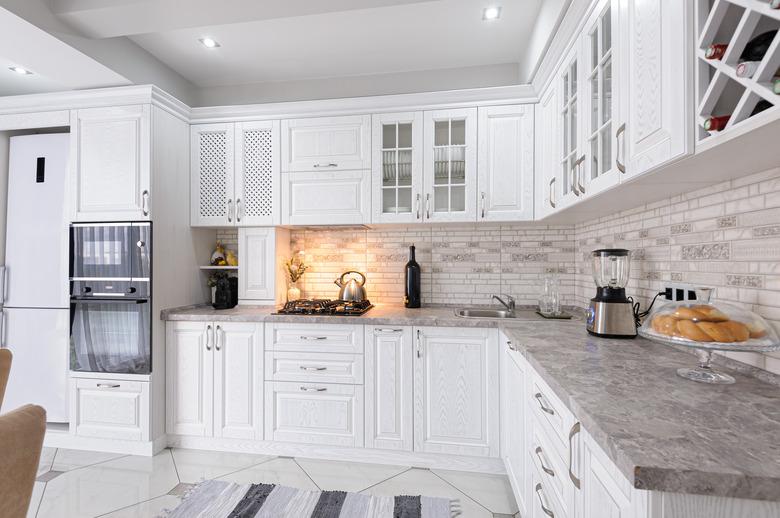The Best Tools For Sanding Kitchen Cabinets
As Minwax explains, proper preparation is the key to a good finishing job, and that means sanding. A folded piece of sandpaper sometimes is all you need to prepare your project. Add a sanding block and you can tackle almost any sanding job.
Power sanders have their place, though, when you need to remove material fast or when the going gets rough. Delicate sanding tools are on the other end of the spectrum. With simple shapes and purposes, these smaller tools are used for getting into tight spaces or to sand odd-shaped parts.
Tip
Cabinets are best sanded when disassembled as much as possible. Remove the doors, drawers, drawer fronts and hardware. Lay the wooden parts out flat across a worktable or a pair of sawhorses and work on them one at a time.
Folded Sandpaper for All-Purpose Sanding
Use 100-grit sandpaper for all-purpose sanding. It's aggressive enough to get the job done but not so aggressive that it leaves scratches that can't be removed. Fold it four ways, bend it around your fingers and sand with short, back-and-forth motions. Cabinet shops rarely use anything but 100-grit sandpaper.
Orbital Sanders for Bulk Sanding
Orbital sanders are best for bulk sanding. Equipped with 100-grit sandpaper, orbital sanders remove surface material from cabinets and doors without going too deep. Light-grit sandpaper such as 120- or 180-grit on an orbital won't remove material fast enough. Heavy-grit papers, 60- to 80-grit remove material too fast and create scratches that weren't there before.
Sometimes referred to as palm sanders, the vibrating pad of the orbital revolves in tight circles. Use orbital sanders on doors, drawer fronts and cabinet sides, jambs, and faces. Check and change sandpaper regularly. Cabinets that have been previously finished have resins, impacted stains, oils, and dirt that ruin sandpaper. When the sandpaper fills with dirt or gunk, change it; if it gets smooth, change it.
Hand Blocks for Even Finishes
After sanding everything with an orbital, resand everything by hand with a hand block and 100-grit sandpaper, always sanding parallel to the grain. This final pass removes sanding marks that may have wandered across the grain, or swirls created by the orbital sander. The finish will be even, consistent, and without the blotching associated with finer-grit papers that tend to close pores and polish wood.
Oscillating Tools for Tight Corners
Orbital sanders are sufficient for most flat surfaces. If your cabinet doors are raised-panel, inset-panel, profiled, or anything but plain, you need finer sanding tools. Oscillating tools get into tight spaces, and Wood Magazine recommends you add one to your toolbox.
With a variety of changeable heads, it's easy to find one that fits custom shapes and tight spaces, rounded edges, or corners. With sticky, 100-grit sandpaper pads that stick on the heads, use oscillating tools to sand kitchen cabinets parts that aren't flat.
Custom-Made Tools for Special Projects
Delicate sanding is done by hand with custom-made tools. Cut a piece of 100-grit sandpaper into square pieces and use your fingers to shape it around rounded moldings and trim. Wrap strips around a dowel and use it to sand curves and profiled moldings. Cut some 1/4 x 3/4 x 3-inch sticks and flatten the ends. Wrap 3/4-inch strips of sandpaper around the flattened end and use the stick to sand in corners and along edges.
Sanding Sponges for Tight Spaces
Sanding sponges are contemporary sanding tools. These bendable sponges are available with moderate to light abrasiveness. Sponges bend, shape, and conform to almost any profile and get into spaces where other tools won't reach. They're particularly useful for cabinets with lots of dips, curves or custom woodworking shapes that don't work with other sanding tools.
Belt Sanders for Rough Sanding
Belt sanders are aggressive and should be reserved for rough wood, or in some instances, to remove an old finish. They tend to leave dips, gouges, scratches, or marks on cabinet doors or woodworking of any type.
Belt sanders are appropriate to smooth wood only if you've purchased rough lumber from a mill or are dealing with deep gouges and scratches. Belt sanders are OK to use on fir or construction plywood, but never use belt sanders on hardwood plywood as the veneer is skin-deep and a belt sander will damage it with the slightest touch.
Chemical Strippers: Worth the Mess
The majority of, if not all, kitchen cabinets have a lacquer or paint finish. If you're serious about sanding cabinets, the removal of the finish comes first. Sanding off an old finish is time-consuming and difficult at best. The use of chemical strippers can save time, money, and effort.
It's a process of brushing it on, allowing it to soften the finish, and scraping everything off. When the stripping is complete and the cabinets are dry, the sanding can begin.
Be warned, however, that chemical strippers are caustic. Wear safety glasses, gloves, skin and breathing protection, and use strippers only in well-ventilated areas. The process might seem intimidating, but the time saved by using strippers typically outweighs the disadvantages.
